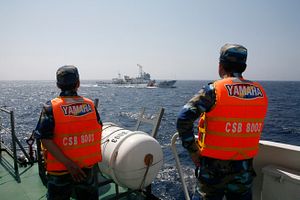For decades what happened in the Spratly Islands was easy to keep secret. Unless one of the countries occupying the coral specks – or the United States – decided to go public, everything was kept safely “over the horizon.” Commercial satellite imagery has changed all that. These days you can’t move a cement mixer in the Spratlys without someone noticing.
But the claimants don’t need satellites to see what their rivals are up to. Some of the occupied reefs and islands are so close that a pair of binoculars will suffice. China’s garrison on Johnson Reef is just 6 km (3.7 miles) from Vietnamese forces on Collins Reef and Beijing’s base on Subi Reef is only 26 km (16.1 miles) from the Philippine forces on Thitu Island. The Vietnamese and Philippine governments must therefore have been aware of China’s massive island-building operations within days of them starting. Asia’s largest dredging vessel, the German-designed Tian Jing Hao, began operations at Cuarteron Reef on September 9, 2013. Vietnam has a base on East London Reef just 30 km (18.6 miles) away, yet it was not until May 2014 that either Hanoi or Manila made any public reaction. What explains the silence?
Vietnam’s quietude was probably the result of two considerations: firstly its long-standing desire to settle controversial matters with its brother communists privately – and away from the gaze of angry nationalists. A probable second motive was that Vietnam’s criticism would have been blunted by its own record of land creation. According to the Center for Strategic and International Studies’ Asia Maritime Transparency Initiative (AMTI), since 2010 Vietnam had doubled the size of its (natural) island base at Sand Cay and, since August 2012, created 65,000 square meters of artificial land at West London Reef.
The Philippines had other concerns. According to a former security adviser to the Philippines government, Manila’s reluctance to go public derived from an embarrassing incident in early 2013 when the Philippines accused China of building on Scarborough Shoal only to discover that the structures were actually parts of a lighthouse that the Philippine Coast Guard had built in the early 1990s!
































